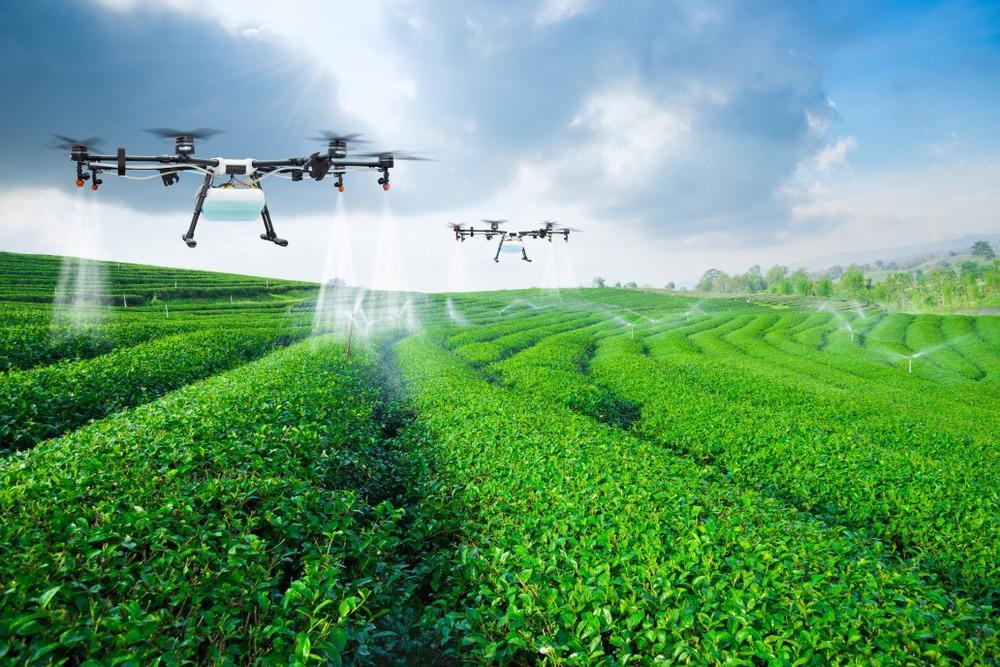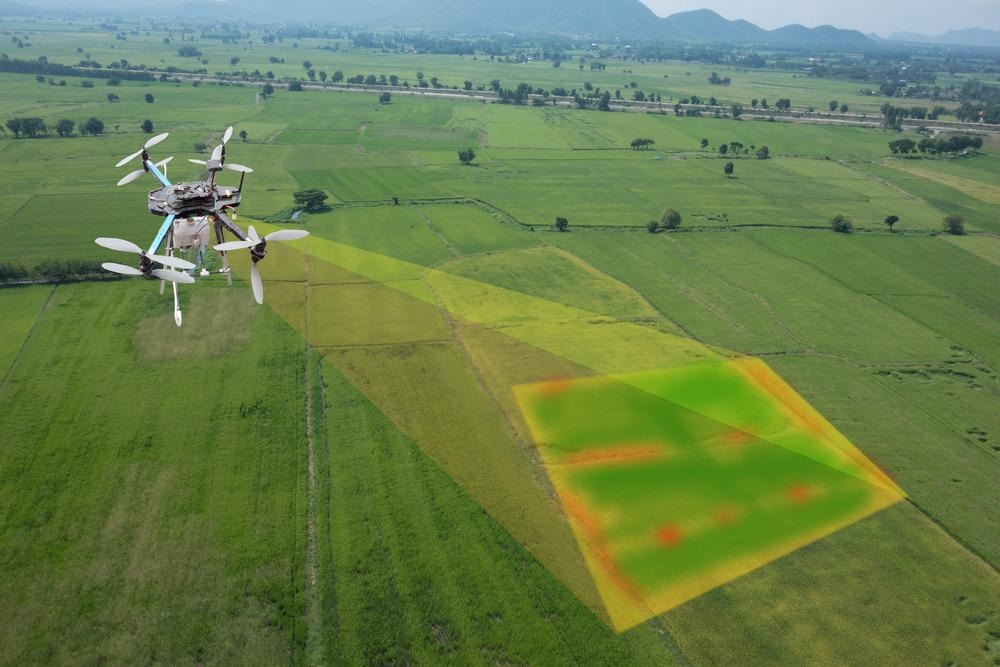Drones provide an alternative source of labor on unprecedented spatiotemporal scales. The future of drones in agriculture is also promising, as drones are being developed to act as mechanical pollinators and to incorporate smart applications, making drones a promising and affordable technology to address the challenge of growing food insecurity.

Image Credit: Suwin/Shutterstock.com
The emergence of smart technology in contemporary agriculture
To address the food demands of a rising human population, agricultural practices have integrated a growing number of technologies with the aim to increase crop yield and reduce operative expenditure. This trend has led to the incorporation of so-called ‘smart technologies’ such as artificial intelligence and automated machinery in many stages of food production, from crop planting and livestock guarding to food processing and transport.
One particular innovation is the use of drone technology. Drones can be described as “Unmanned Aerial Vehicles” (UAVs) but are also referred to as “Unmanned Aircraft System (UAS),” or “Unmanned Aircraft (UA)” that are piloted remotely or have been assigned a flight path by an operator.
Drones have mostly been associated with military practices or for recreational purposes, but recent developments, particularly in sensors and imaging processing, have broadened the scope and applicability of drones. The reduction of drone costs and the increased accessibility of technologies, occurring simultaneously to technological progress, has also further accelerated the popularity of drones, allowing drones to be used in other industries such as agriculture.
Modern drones now offer a range of open-source technologies, smart sensors, and longer flight times, and therefore provide a number of benefits for agricultural practices from monitoring and observation to crop protection.
The diverse applications of drone technology in agriculture
A 2017 review of scientific literature by Puri et al. presented the commercial agricultural applications of drones currently applied around the world. Authors use examples from Germany, where drones are used frequently to mow meadows, determine yield losses from wild boar damage, or distribute beneficial insects among crops to act as bioremediators.
The study discusses how drones are particularly useful for improving practices of precision farming, which has gained traction in recent years. Smart, or precision farming, uses a combination of ground and satellite applications to enable site-specific processing of images to document agricultural lands. This practice provides a certain autonomy without the need for invasive sampling, but also expands available spatiotemporal scales, which is compatible with drone technology.
The review by Puri et al. then categorizes the primary applications for drones into the different areas of commercial agriculture.
First, drones are ideal for monitoring and sensing practices as they can rapidly cover land to monitor the growth and health of crops and soil. This is the main use of drones as their sensors are able to monitor the absorbance of a specific wavelength, forming a color contrast image visually reflecting potentially problematic areas.
This monitoring capacity not only allows for rapid processing of spatiotemporal information, but ranchers have also used drones to track livestock on ranches, as well as check for any damaged fences. To better monitor livestock, rangers have also used night cameras and thermal imagers to find any animals that are harassing and attacking herds.
The second main application for drones in agriculture is to maintain crop health through watering, fertilizer, and pesticide dispersal. Drones equipped with spectroscopy and thermography technologies can find dry areas within and address problematic areas that may have been missed by conventional watering equipment. Conversely, drones can also detect equipment leaks as well as irrigation issues.
Over time, drones can stitch thermographic images together to determine the direction of water flow across the land and identify land features that may affect water dispersion. The accuracy and rapidity of drones also allow fertilizer to be deployed to specific areas if crops are not growing sufficiently, and for pests and pathogens to be eradicated by spraying pesticides from drones themselves.
Drones can also act as mechanical pollinators, providing a third key benefit. Although insect vectors remain the most important pollinators, drones may eventually provide vital support, particularly with the decline of bees. Progress is required in this particular field, but researchers are confident drones may be able to effectively transport and disperse pollen seeds in orchards or fields.
Another key for drone application is the use of drones for agricultural investigations. From pathogens to insurance claims, drones are able to cover large areas damaged by natural disasters to uncover the causes and consequences of incidents. Agricultural insurance surveys are already applying drones to validate claims, and the fast response combined with high-resolution imaging provides the possibility to collect information over large scales, which is difficult, if not impossible, to accomplish on the same timescale if manual labor is required.
Together, these benefits make drones promising candidates for improving agricultural practices at a relatively small cost. Alongside economic benefits, optimizing fertilizer, pesticide, and water usage, to key areas, also alleviates several ecological and environmental impacts that would not be possible conventionally.
Examples of drone types that are able to carry out all these tasks have been developed in recent years and costs for these models are decreasing consistently. For instance, in 2012, the company DJI was the first to deploy drone technology to agriculture, and offer drone technology to over 30 countries around the world and 10 million agricultural practitioners.
DJI models have recently developed the T20 plant protection drone, which can carry out control operations on many crop types. The company has also developed the sow system 2.0, which allows for drones to carry out sowing operations across entire fields or specific areas through the design of custom-made maps. Drones and their associated technologies are therefore becoming increasingly refined, and are gradually incorporating a broader range of applications.

Image Credit: MONOPOLY919/Shutterstock.com
Limitations and implications: the future of drone technology in agriculture
Despite the recognized benefits of drone technology, several challenges remain before the widespread adoption of drones across agricultural systems.
Similar to other emerging innovations, public perception of drones remains divided. This may be associated with the lack of a framework that standardizes practices of drones, thus making drones appear as a technology that is not adequately regulated and is yet to be harnessed.
A 2020 study by Ayamga et al. offers more insights into the international regulations of drones, and proposes a new approach to improving the inclusion of stakeholders and regulators to implement and enforce developed regulations, ultimately improving public perception.
Despite divided perceptions, a study by Ren et al. (2020) suggests that drones may be creating a new agricultural revolution, reaching a market value worth billions of dollars over coming years. The authors of the study suggest this may be a result of the rapidly changing environmental and demographic conditions the world is currently experiencing.
For instance, global climate change and growing food insecurity are challenges that drones can directly contribute towards by improving crop health and yield. Gerard Sylverster, editor of the UN Food and Agriculture Organization and the International Telecommunication Union's research report on "UAVs and agriculture", states that farmers work to adapt to climate change and meet other challenges, but drones are expected to help the entire agricultural enterprises improve efficiency.
In an era of rapid technological innovation, drones are also expected to improve in accuracy, duration, and applicability. The integration of software offers particularly promising results that will also improve the usability and costs, making technology more accessible to stakeholders.
This was the objective of drone developing company Drone AG, which has integrated a number of software applications. Their models now cover a crop scouting system, compatible with mobile users, as well as crop spraying drones and multispectral mapping drones.
Such innovation will bolster the efficacy of drones as well as provide farmers with more tools to maintain food security amid a rapidly changing world.
Sources:
- Ayamga, M., Tekinerdogan, B., Kassahun, A., & Rambaldi, G. (2020). Developing a policy framework for adoption and management of drones for agriculture in Africa. Technology Analysis & Strategic Management, 33(8), 970–987. doi: 10.1080/09537325.2020.1858047
- Daponte, P., de Vito, L., Glielmo, L., Iannelli, L., Liuzza, D., Picariello, F., & Silano, G. (2019). A review on the use of drones for precision agriculture. IOP Conference Series: Earth and Environmental Science, 275(1), 012022. doi: 10.1088/1755-1315/275/1/012022
- DJI Agriculture. (2021, November). DJI Agriculture. https://ag.dji.com/
- Drone Ag – Hassle-free drone automation and AI for Agriculture. (2021, November). Drone AG. https://droneag.farm/
- Puri, V., Nayyar, A., & Raja, L. (2017). Agriculture drones: A modern breakthrough in precision agriculture. Journal of Statistics and Management Systems, 20(4), 507–518. doi: 10.1080/09720510.2017.1395171
- Ren, Q., Zhang, R., Cai, W., Sun, X., & Cao, L. (2020). Application and Development of New Drones in Agriculture. IOP Conference Series: Earth and Environmental Science, 440, 052041. doi: 10.1088/1755-1315/440/5/052041
Further Reading
Last Updated: Mar 4, 2022